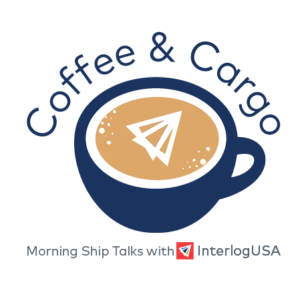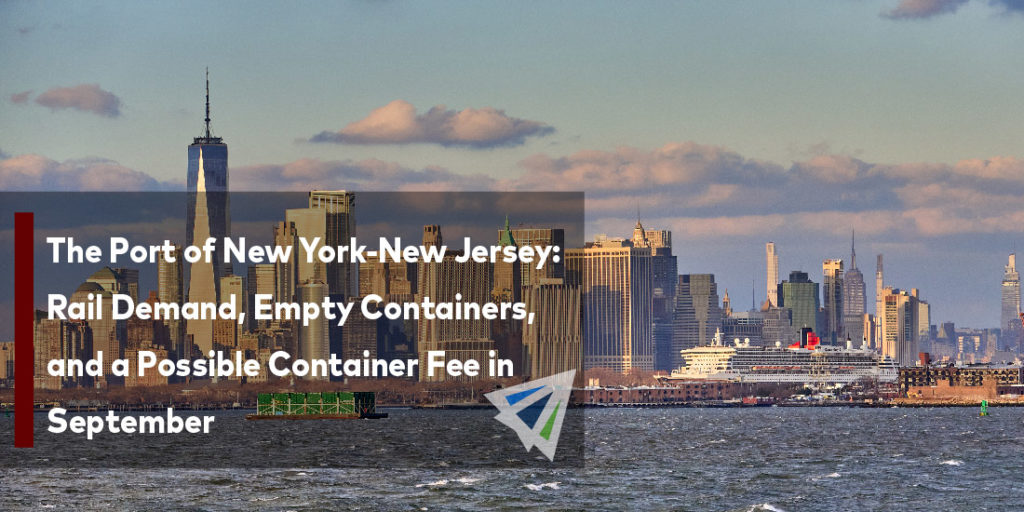Competitive Edge
Headlines
- Air cargo volumes have fell 9% year-over-year in July, continuing a trend of heading downward. Additionally, airfreight rates have dropped as a shift to ocean transport has been occurring. We discuss this topic more in our Interlog Insights newsletter, sign up here if you’re interested in hearing more.
- There are plans to place an inland port in the middle of the Mojave Desert in California by 2023, after officials gave the ‘all clear’ on the project last week. The inland port would be placed 90 miles outside of the LA/LB ports.
Courtesy: Supply Chain Dive and CBS News
UPDATE: U.S./Canada Ports – Number of Vessels at Anchor as of 08-16-22
- Savannah: 36 Vessels at Anchor (-3)
- Houston: 33 Vessels at Anchor (+5)
- Vancouver: 24 Vessels at Anchor (-1)
- New York/Newark: 16 Vessels at Anchor (0)
- Los Angeles/Long Beach: 11 Vessels at Anchor (-2)
- San Francisco/Oakland: 6 Vessels at Anchor (-2)
- Charleston: 0 Vessels at Anchor (-2)
Note: This count does not include vessels moored and being unloaded at port docks. Colored numbers in parentheses represents the change from last week over.
Courtesy: MarineTraffic
IMPORT: Asia to North America (TPEB)
Recent Developments:
- Contract negotiations between the International Longshore and Warehouse Union (ILWU) and Pacific Maritime Association (PMA) remain active. The existing labor contract between the two parties expired July 1.
- Both the ILWU and PMA have commented neither is planning on striking or shutting down operations amid ongoing talks. The two parties state their confidence that there will be no disruptions at USWC ports.
- Sources close to the talks speculate a deal will be reached by August or September. However, there has been no official comment or release from either party that confirms this is true.
Rates: Spot rates from Asia to the US East Coast continue to decrease.
Major container lines CMA CGM and Hapag-Lloyd have also instituted surcharges on overweight container loads from India to the U.S. and Canada.
- CMA CGM is charging $1,000 per TEU for all types of containers weighing over 20 metric tons.
- Hapag-Lloyd is charging $500 per TEU for loads exceeding 18 metric tons.
Container line MSC has scaled down its planned peak season surcharge (PSS) for Indian container loads to the US, while also delaying the implementation date, reports indicate. The carrier has recalled its $2,000-per-container PSS notice that was to take effect Aug. 1 and instead now plans to seek $1,000 per box from Aug. 22, it said in a customer advisory.
Space: Space is generally open at this time.
Capacity: Capacity has tightened in pockets. Shippers continue to divert cargo to the USEC due to fears of disruptions at West Coast ports from ongoing labor talks.
Equipment: Some inland terminals are reaching max capacity with inventory. Intermodal systems remain stressed with congestion and truck and chassis deficits.
- North American chassis manufacturers have ran into production delays in 2022 (for the second consecutive year), reports indicate. This stems from difficulties in sourcing raw components and retaining factory workers.
TIPS: Book at least 2-3 weeks prior to ready date. Strongly consider premium services and, if cargo is ready now, make plans to move as soon as possible with the current openings in space and fallen rates. When possible, shippers with fixed-rate contacts should take advantage of these softened rates on the floating market.
For more on the TPEB import lane, sing-up to our Interlog Insights Weekly Newsletter! In our August editions, Interlog’s experts are dissecting why shippers are rerouting to the East and Gulf coasts and how this decision has subsequently led to a shift in our country’s port congestion.
IMPORT: Europe to North America (TAWB)
Recent Developments:
- Northern European hubs remain critically congested. Labor-related tensions continue to pose disruptions to German, Dutch, and British ports.
- 2,000 dockworkers at Britain’s largest port, Felixstowe, are planning on striking from August 21 to 29, the representative union said in a statement.
- USWC ports have seen alleviated congestion and improvements to vessel waiting times—yet still a far cry from pre-pandemic standards.
- There are no disruptions directly related to ongoing WC labor talks.
- On the USEC, both ports of New York/Newark and Savannah remain having a significant number of backlogged vessels at anchor off their respective shores.
Rates: Rates remain elevated, but consistent, for the foreseeable future. Higher fuel costs are contributing to rate increases.
Space: Space remains critical to USEC routings. Meanwhile, there’s been slight openings in space for USWC direct routings.
Capacity: Capacity for both North Europe and Mediterranean services remain gripped.
Equipment: Equipment at European seaports is not as readily available as it has been for the past few months. Inland terminals in Europe are also still reporting equipment shortages. On the U.S. side, truck and chassis availability remain concerning, especially with the latter.
TIPS: Book 5 or more weeks prior to ready date. Shippers are strongly advised to use premium service for no-roll options and improved reliability for their cargo.
For more on the planned labor strikes at Britain’s largest port, Felixstowe, sing-up to our Interlog Insights Weekly Newsletter! Our August editions are also including follow ups on any developments that occur regarding this subject in closer detail.
EXPORT: North America to Asia
Recent Developments:
- For the USEC, waiting vessels remain an issue for Savannah and New York/Newark.
- Diminished schedule integrity continues to challenge post earliest return dates.
- Vessel arrivals remain smooth for USWC POLs.
Rates: So far, GRIs for the transpacific westbound lane have not been announced for August.
Capacity: Available capacity remains fluid for USWC POLs.
Equipment: Truck, container, and chassis availability remains dire and has significantly contributed to congestion of the intermodal system and IPI origins. Standard equipment at ports remains available unless carriers advise otherwise.
TIPS: Book 4 to 5 weeks prior to time of departure to secure necessary equipment and vessel space.
Did You Know: The Port of Mobile had a strong month in July
The Port handled 316,473 TEUs (twenty-foot equivalent units), which is a little over a 12 percent increase from 2021.
Something to note is the impressive fluidity at the Port. They are able to transit cargo from ship to Chicago in just two days’ time.
Source: AJOT
Freight News
Federal Maritime Commission is considering implementing a 60-day congestion emergency order
It’s no secret that congestion has been an issue for the supply chain industry. Now, the FMC is seeking public comments on whether the supply chain congestion is bad enough to order carriers and container terminals to share some of their data directly with shippers, railroads and drayage truckers.
The FMC’s goal with this potential emergency order is to improve the efficient transportation, loading and unloading of cargo to or from any inland destination or point of origin, any vessel or any point on a wharf or terminal, Freightwaves notes.
If this emergency order takes place, it would last up to 60 days – with the option to extend it.
The recently passed Ocean Shipping Reform Act of 2022, gives the FMC authorization to issue an emergency order like this, once they receive comments from the public on the following questions:
- Has congestion created an emergency situation of a magnitude to have a substantial, adverse effect on the competitiveness and reliability of the international ocean transportation supply system?
- Would an FMC emergency order alleviate the emergency situation?
- What would be the appropriate scope of an emergency order?
The public will have 30 days from when the Request for Public Comment becomes available in the Federal Register to submit their views to the FMC.
We might be discussing this topic in our upcoming Interlog Insights newsletters, so be on the lookout for that. If you would like to sign up, please click here.
Production delays remain for chassis manufacturers in 2022, when will chassis shortages ease?
Equipment shortages in the supply chain industry seem to make headlines on a daily basis with how much of an issue it continues to be. 2022 has been the second straight year that North American chassis manufacturers have run into production delays. Import demand in the U.S. has outpaced the supply of chassis throughout the last two years as well, the Journal of Commerce reports.
With these higher volumes, many shippers are holding onto chassis for longer than they did pre-pandemic averages. This is causing more pressure on equipment manufacturers to get more units off the assembly line.
Furthermore, some shippers are deciding to leave their laden import containers at the dock, instead of taking on chassis to bring them to warehouses that are overflowing. This has caused major congestion at large U.S. ports and railroad terminals, especially in Chicago, Dallas, Kansas City, Memphis, and the Ohio Valley – the JOC reports.
Some suppliers have been behind schedule since January, and shortages have affected a variety of parts. One chassis manufacturer told the JOC orders that are expected to be delivered this year will most likely be pushed into 2023, as orders for next year get pushed into 2024.
Why is that?
A shortage of parts can be primarily to blame. If you did not know, constructing a single chassis requires raw materials from subcomponents from 20-30 separate suppliers. To make things even more challenging, all these suppliers must be in sync and be able to deliver parts on a regular and predictable schedule. If any of the suppliers falls behind, the manufacturer will not be able to put together a finalized chassis to deliver to chassis users, details the JOC.
Sign up for next month's webinar!

Make sure you sign up for our next webinar that is taking place on Wednesday September 21st where we will be discussing current and exciting topics in the freight industry.
If you have never joined our Coffee and Cargo webinar click the "Watch now" button to view our most recent webinar.
We look forward to seeing you there!
Sign up for our
industry answers
Our team works to provide valuable, unique, and relevant content to assist you in finding solutions. Sign up now.


